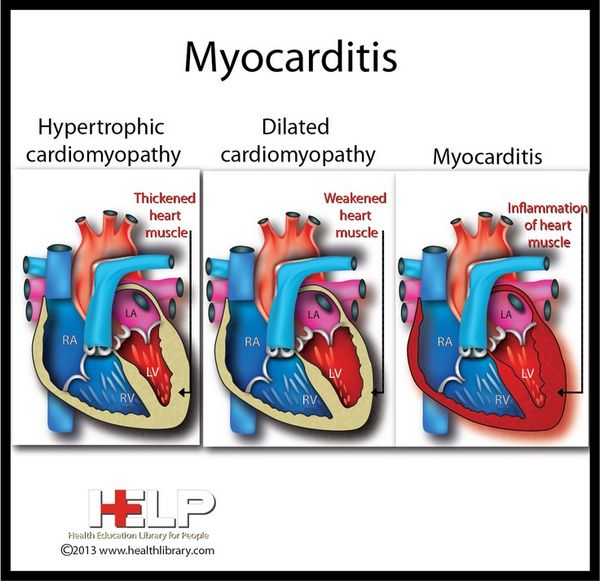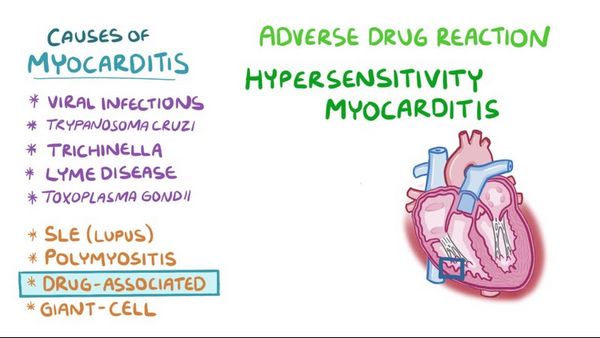Potential Severity
Fulminant myocarditis can be fatal or lead to chronic congestive heart failure. Most cases are self-limiting and are followed by full recovery
The true incidence of myocarditis (inflammation of the heart) is unknown, because most cases are asymptomatic. It has been estimated that 1% to 5% of systemic viral illnesses have myocardial involvement. Young males are at higher risk for serious myocarditis, as are pregnant women, neonates, and immunocompromised patients.
Causes and Pathogenesis
Viruses are a major cause of myocarditis, and specific causation has been identified by Polymerase chain reaction in nearly 40% of patients with myocarditis. Adenoviruses and enteroviruses (Coxsackievirus В and echoviruses) are most commonly detected, but many other viruses have been implicated, including cytomegalovirus and Epstein-Barr virus, varicella virus, mumps, influenza, and Vaccinia (following smallpox vaccination) viruses. Patients with asymptomatic HIV infection have a high incidence of myocarditis (1.6% annually).

Many bacteria have also been implicated as causes of myocarditis, including Legionella and Chlamydia species. Spirochetes can invade the heart, and patients with Lyme disease may present with cardiac arrhythmias. Severe disseminated fungal infections can result in myocarditis. Parasites are also implicated: Trypanosoma cruzi attack the heart in 30% of patients with Chagas’ disease, and heavy infestation with Trichinella can cause fatal myocarditis.
Viruses directly invade myocytes and can cause direct damage to the infected cells. The immune response to infection also causes cytotoxicity. T cells predominate the myocyte infiltration, accompanied by macrophages and В cells. Circulating auto-antibodies directed against mitochondria and contractile proteins are frequently detected. Cytokines and oxygen-free radicals have also been implicated as contributors to myocyte damage. Forced exercise, pregnancy, use of steroids or nons-teroidal anti-inflammatory agents, consumption of ethanol, and nutritional deficiencies have all been implicated as factors that predispose to symptomatic myocarditis.

Clinical Manifestations, Diagnosis, and Treatment
The pace of illness and the symptoms vary greatly from patient to patient. Some patients experience a flu-like illness that can be accompanied by chest pain when the pericardium is involved. Other patients present with arrhythmias or symptoms and signs of right- and left-sided congestive heart failure. Left ventricular dilatation can lead to expansion of the mitral valve ring and a mitral regurgitant murmur.
Cardiac enzymes are elevated in a few cases. Levels of creatinine kinase antibodies are elevated in only 5% of cases and cardiac troponin I in 34%. Elevations are most commonly detected within the first month of symptoms and suggest ongoing myocyte necrosis. Acute and convalescent viral titers may be drawn and will detect recent viral infections, but this test should not be considered proof of a viral cause. Echocardiog-raphy is very helpful for assessing cardiac contractility, chamber size, valve function, and wall thickness.
Contrast-enhanced magnetic resonance imaging allows for detection of the extent and degree of inflammation, parameters that correlate with left ventricular function and clinical status. Definitive diagnosis requires endomyocardial biopsy. Timing of the biopsy and interpretation by an experienced pathologist are critical. Analysis by Polymerase chain reaction of biopsy tissue remains experimental, and the specificity and sensitivity of the assay remains to be determined.
Treatment for viral myocarditis is evolving. In patients with persistent virus in the myocardium, β-interferon administration has been associated with clearance of the virus and improvement in myocardial function. Immunosuppressive agents have failed to improve outcome, and administration of immunoglobulins has not been proved to be of benefit.
Exercise restriction limits the work required by the inflamed heart and has been shown to be beneficial in a mouse model of viral myocarditis. In-hospital cardiac monitoring may be required during the acute phase of myocarditis to prevent potentially life-threatening arrhythmias. Anti-arrhythmic drugs must be used cautiously because of their negative inotropic effects. To reduce the risk of mural thrombi and systemic emboli, warfarin anticoagulation should be considered in patients with an ejection fraction below 20%. In most cases of viral myocarditis, patients recover completely; however those with fulminant disease may die.
Severe cardiac damage can lead to refractory congestive heart failure that can be corrected only with cardiac transplantation.
About Myocarditis
- Primarily caused by adenoviruses and entero-viruses (Coxsackievirus В and echoviruses).
- In asymptomatic HIV, incidence of myocarditis is 1.6% annually.
- Risk factors for symptomatic disease include forced exercise, pregnancy, steroids or nons-teroidal anti-inflammatory agents, consumption of ethanol,and nutritional deficiencies.
- Many patients are asymptomatic. Some develop
- flu-like illness, sometimes with chest pain;
- arrhythmias,and
- congestive heart failure.
- A physical exam reveals S3 gallop (indicating left-sided congestive heart failure), mitral regurgitation resulting from ring dilatation.
- In a few cases, cardiac enzymes are elevated.
- Echocardiography is very helpful; magnetic resonance imaging allows for assessment of the extent of inflammation.
- Endomyocardial biopsy combined with analysis by polymerase chain reaction is experimental.
- Treatment includes p-interferon, bed rest, drugs for congestive heart failure and arrhythmias, anticoagulation.
- Full recovery is usual; however, fulminant cases may require heart transplant.






